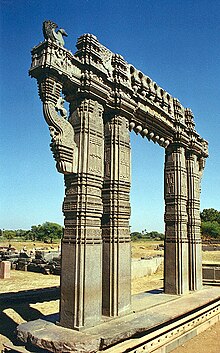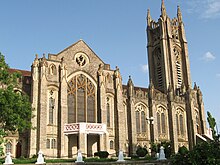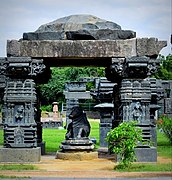Culture of Telangana

| Part of a series on the |
| Telangana culture |
|---|
 |
The Culture of Telangana in
Languages of Telangana
About 76% of the population of Telangana speak Telugu, 12% speak Urdu, and 12% speak other languages.[6][7] Before 1948, Urdu was the official language of Hyderabad State, and due to a lack of Telugu-language in educational institutions, Urdu was spoken by the educated people of Telangana, including the elite. After 1948, once Hyderabad State joined the new Republic of India, Telugu became the language of government, and as Telugu was introduced as the medium of instruction in schools and colleges, the use of Urdu among non-Muslims decreased.[8]
Literature
Poets of Telangana from the early era include
Urdu literature has always enjoyed patronage from successive rulers of the Qutb Shahi and Asaf Jahi era. Mohammed Quli Qutb Shah, the fifth ruler of the Qutb Shahi dynasty is regarded as one of the pioneers of early Urdu poetry.
During the rule of
Religion
The major religions of the people are
In terms of influence, Islam occupies the second place. It started spreading from the 14th century onwards. Mosques began to come up in many parts of the region during the Muslim rule. Christianity began to spread from 1701, especially among the socially disabled people. Educational institutions and churches grew in number in the Circars in the 18th-19th centuries when the East India Company and later the British government encouraged them. Other European countries were also active in building churches and taking care of the weaker sections of the people.
Major Religious Structures
Yadadri : Lord Vishnu (whose reincarnation is Lord Narasimha). The main deity is Lakshmi Narasimha Swamy.
Karmanghat Hanuman TempleThe Karmanghat Hanuman Temple is one of the oldest and popular Hindu temples in Hyderabad, in the state of Telangana, India. The presiding deity of the temple is Lord Hanuman and the temple complex also houses other deities viz. Lord Rama, Lord Shiva, Goddess Saraswathi, Goddess Durga, Goddess Santoshimata, Lord Venugopala Swamy, and Lord Jagannath. The temple is located at Karmanghat, near Santoshnagar and closer to the Nagarjuna Sagar Ring Road.

Alampur Jogulamba TempleJogulamba temple is a Hindu temple dedicated to Goddess Jogulamba, a form of Shakti located in Alampur, Telangana, India. The temple is one of the Maha Shakti Peethas, a group of eighteen (Ashtadasa) temples considered the most significant shrines and pilgrimage destinations in Shaktism. Alampur is located on the banks of the Tungabhadra river near its confluence with Krishna river. Jogulamba temple is located in the same complex as that of the Navabrahma Temples, a group of nine Shiva temples built in the seventh-eighth century CE.
Birla Mandir, Hyderabad: Built on a 280 feet (85 m) high hillock called Naubath Pahad on a 13 acres (53,000 m2) plot in Hyderabad
Medak Church at Medak in Telangana, India, is the largest church in Telangana and has been the cathedral church of the Diocese of Medak of the Church of South India since 1947. Originally built by British Wesleyan Methodists, it was consecrated on 25 December 1924. The Medak diocese is the single largest diocese in Asia and the second in the world after the Vatican.[15] The church was built under the stewardship of the Methodist Christian, the Reverend Charles Walker Posnett, who was driven by the motto My best for my Lord. Charles Posnett had arrived in Secunderabad in 1895, and after first ministering among British soldiers at Trimullghery, had launched into the villages and had reached Medak village in 1896.[16]
Banjara (Lambadi) spiritual / religious persons
Festivals
Festivals are celebrated with much fervor and people used to go to temples on these days to offer special prayers. Some of the Festivals are 
Regional festivals
Telangana's citizens (Telanganites) also celebrate festivals like 'Visual arts
Paintings
Nirmal paintings are a popular form of painting done in Nirmal in Adilabad District. The paintings have golden hues.[20][21] The region is well known for its
Sculpture
Ramappa Temple:It lies in a valley at Palampet village of Venkatapur Mandal, in erstwhile Mulug Taluq of Warangal district, a tiny village long past its days of glory in the 13th-14th centuries.[24] An inscription in the temple dates it to the year 1213 and said to have been built by a General Recherla Rudra, during the period of the Kakatiya ruler Ganapati Deva.

This medieval temple is a Shivalaya (where Shiva is worshipped) and named after the sculptor Ramappa. It is the only temple in the world named after its sculptor/architect. Its presiding deity, Ramalingeswara, is the form of Shiva and a personal god of the Avatar of Vishnu, Rama. The history says that it took 40 years to build this temple. Planned and sculpted by Ramappa, the temple was built on the classical pattern of being lifted above the world on a high star-shaped platform. Intricate carvings line the walls and cover the pillars and ceilings. Starting at its base to its wall panels, pillars and ceiling are sculpted figures drawn from Hindu mythology.[25] The roof (garbhalayam) of the temple is built with bricks, which are so light that they are able to float on water.[26]
Architecture


Alampur Temples:There are a total of nine temples in Alampur, all dedicated to Shiva. These temples date back to the 7th century A.D, and were built by the Badami Chalukyas rulers, who were great patrons of art and architecture. Even after a time span of several hundred years, these grand temples still stand firm reflecting the rich architectural heritage of the country.
The temples are emblematic of the Northern and Western Indian styles of architecture. They do not reflect the Dravidian style of architecture as is generally common with the temples in this region. The shikharas of all these temples have a curvilinear form and are adorned with the miniature architectural devices. The plans and decoration similar to that of the rock cut temples. The Alampur Navabhrama Temples are historically important and reflect remarkable architectural skills.
Alampur was previously Known as Halampuram, Hamalapuram And Alampuram. Name of this place as Hatampura, mentioned in the inscription dated AD 1101 belongs to
Kakatiya
The best examples of architecture under the Kakatiya dynasty (1163–1323) are the ruins of the Warangal Fort.
In The
It was destroyed by the invasion of Tuglaq dynasty to South India. However, Mir Osman Ali Khan, the 7th Nizam of Hyderabad, contributed immensely towards re-building the temple.[29] The temple consists of one building and temple building. There are one thousand pillars in the building and the temple, but no pillar obstructs a person in any point of the temple to see the god/deity in the other temple.

Apart from Warangal, the
Indo-Islamic
Early Indo-Islamic style of architecture is reflected in the monuments built by the
Modern
During the reign of the Nizams of Hyderabad, European styled palaces and buildings became prevalent in the city of Hyderabad. Among the oldest surviving examples of architecture of this time is the Chowmahalla Palace, which showcases a diverse array of architectural styles, from the Baroque Harem to its Neoclassical royal court. The other palaces include Falaknuma Palace (inspired by the style of Andrea Palladio), Purani Haveli and King Kothi Palace all of which were built during the 19th century.
In the early 20th century, British Architect

-
Kakatiya Kala Thoranam at the Warangal Fort, the capital of the Kakatiya dynasty. The fort was destroyed by the Delhi Sultanate in the 13th century.
-
Ramappa Temple built by the Kakatiya dynasty in the 11th century.
-
Golconda Sultanatein the 16th century.
Cultural sites
Telangana has many museums which depicts the culture of the erstwhile kingdoms of the state. The
The Telangana State Archaeology Museum in Hyderabad also houses a collection of rare Indian sculpture, art, artifacts as well as its most prized exhibit, an Egyptian mummy. The other prominent Museums are Nizam Museum, Warangal Museum, City Museum, Hyderabad and Birla Science Museum.
Cuisine

Telangana has two types of cuisines, the Telugu cuisine and Hyderabadi cuisine.

Hyderabadi cuisine is the cuisine of the
Performing arts
Dance
Perini Sivatandavam or Perini Thandavam is an ancient dance from Telangana which has been revived in recent times.[37]
The Perini Thandavam is a dance form usually performed by males. It is called 'Dance of Warriors'. Warriors before leaving to the battlefield enact this dance before the idol of Lord Shiva. The dance form, Perini, reached its pinnacle during the rule of the 'Kakatiyas' who established their dynasty at Warangal and ruled for almost two centuries. It is believed that this dance form invokes 'Prerana' (inspiration) and is dedicated to supreme dancer, Lord Shiva.
Bonalu The
Music
Telangana has a diverse variation of music from carnatic music to folk music. [Kancherla Gopanna,[38] popularly known as Bhakta Ramadasu or Bhadrachala Ramadasu was a 17th-century Indian devotee of Rama and a composer of Carnatic music. He is one among the famous vaggeyakaras (a person who not only composes the lyrics but also sets them to music; vāk = word, speech; geya = singing, singable; geyakāra = singer) in the Telugu language. there are many types of instruments in telangana
The folk songs of Telangana had left a profound impact on the Statehood movement[39] as it played a significant role in the success of the Dhoom-Dham, a cultural event that was a vital part of the agitations.
Some of the known folk singers who took active part in the Telangana movement are Gaddar, Belli Lalitha, Sai Chand, Vimalakka and singers like Deshapati Srinivas and Rasamayi Balakishan.
Oggu Katha

Oggu Katha or Oggukatha is a traditional folklore singing praising and narrating the stories of Hindu gods
The narrator and his chorus i.e. two or more narrators-help in dramatizing the narration as very often, they transform themselves into two characters. The dramatization of the narrative is what gives the Oggu Katha its predominant place in the ballad tradition in Telangana, where Oggu Katha is prevalent. The singers visit the shrine of Komuravelli Mallanna swamy Temple every year.
Cinema
Telugu cinema, also known by its sobriquet as Tollywood, is a part of
See also
Notes
- ^ The original mud fort of Golconda has been expanded and altered to such an extent by the Bahmani and Qutb Shahi dynasties, that it is no longer considered an example of Kakatiya architecture.
References
- ^ "A brew of Telangana culture". 16 September 2014. Retrieved 27 July 2016.
- ^ "Telangana State Portal Language & Culture". www.telangana.gov.in. Archived from the original on 14 February 2015.
- ^ "Ganga-Jamuni tehzeeb helps maintain peace". deccanchronicle.com. 16 July 2015. Retrieved 13 January 2016.
- ^ "Ganga-Jamuni tehzeeb: Temple serving Iftar Dates to 5 Mosques in Hyderabad". The Siasat Daily. 26 June 2015. Retrieved 13 January 2016.
- ^ "Heritage award for Hyderabad raises many eyebrows". Times of India. 2 March 2012. Retrieved 17 October 2021.
- ^ "Region-wise distribution of religious groups 2001" (PDF). Table 7.3 in page 393 of SKC report. Retrieved 3 June 2014.
- ^ "Urdu in Andhra Pradesh". Language in India. Retrieved 22 January 2013.
- ^ "Census of India – Distributions of 10,000 persons by language". www.censusindia.gov.in. Retrieved 14 September 2010. – People not interested in dividing Andhra Pradesh. [citation needed]
- ^ "Sahitya Akademi award for Samala Sadasiva". The Times of India. 22 December 2011. Retrieved 2 June 2014.
- ^ "Religion Distribution" (PDF).
- ^ "Homam performed at Yadagirigutta". The Hindu. 11 June 2007. Archived from the original on 4 February 2010. Retrieved 13 January 2016.
- ^ ":: Welcome to Bhadrachala Sree Seetha Ramachandra swamy temple". bhadrachalarama.org. Retrieved 13 January 2016.
- ^ "Vemulawada Temple – Sri Raja Rajeswara Swamy Devasthanam: History". vemulawadatemple.org. Retrieved 13 January 2016.
- ^ "Mecca Mosque". Encyclopædia Britannica. Retrieved 3 November 2011.
- ^ "Medak Cathedral". Prasar Bharti (All India Radio). 25 September 2013. Archived from the original on 27 September 2013. Retrieved 25 September 2013.
- ^ "Medak Diocese". Archived from the original on 8 May 2008. Retrieved 20 November 2014.
- ^ "List Lambadi Religious Gurus and saints". Lambadiwala.
- ^ "Banjara Religious Gurus". Lambadi Youth.
- ^ Gollapudi Srinivasa Rao (21 September 2014). "Bathukamma festivities to begin from Sept. 24". The Hindu. Retrieved 13 January 2016.
- ^ "Traditional art emporium at its finest". The Hindu. 12 January 2008 – via www.thehindu.com.
- ^ Staff Reporter (21 July 2010). "Lepakshi expo inaugurated". The Hindu. Retrieved 13 January 2016.
- ^ a b "Miniature painting". Centre for Cultural Resources and Training. Archived from the original on 18 March 2013. Retrieved 9 June 2012.
- ISBN 978-0-85667-153-1.
- James, Ralph; Lefèvre, L (2010). National exhibition of works of art, at Leeds, 1868: official catalogue. The Executive Committee. pp. 301–313. ISBN 978-1-165-04393-4.
- James, Ralph; Lefèvre, L (2010). National exhibition of works of art, at Leeds, 1868: official catalogue. The Executive Committee. pp. 301–313.
- ^ "The Shiva temples at Palampet". Archived from the original on 18 October 2006. Retrieved 11 September 2006.
- ^ "Ramappa Temple – Symphony In Stone". Rakshan Sharma. Archived from the original on 21 October 2006. Retrieved 11 September 2006.
- ^ "Warangal Temples, Andhra Pradesh". Archived from the original on 7 June 2013. Retrieved 11 September 2006.
- ^ "ALAMPUR". Archived from the original on 25 October 2009. Retrieved 26 March 2009.
- ^ 1,000-pillar temple to get facelift – Times Of India. Articles.timesofindia.indiatimes.com (20 July 2003). Retrieved on 2013-08-25.
- ^ "Thousand Pillar Temple, Thousand Pillar Temple Timings, Thousand Pillar Temple History, Rudreshwara Swamy Temple".
- ISSN 0266-6030.
- ISBN 978-1-906098-05-6, p-1033]
- ^ "Needs title". indianexpress.com. The New Indian Express. 29 January 2014. Archived from the original on 18 September 2013. Retrieved 22 February 2014.
- ^ "Needs title". The New Indian Express. 29 January 2014. Archived from the original on 18 September 2013. Retrieved 22 February 2014.
- ISBN 978-81-7991-373-4. Retrieved 8 December 2013.
- ISBN 978-0-8047-5442-2. Retrieved 8 December 2013.
- ^ "Biryani, Haleem & more on Hyderabad's menu". The Times of India. Retrieved 13 January 2016.
- ^ "Telangana Natyam, Perini dance in temples across State". The Hindu. Chennai, India. 16 October 2010. Archived from the original on 20 October 2010.
- ^ "Entertainment Hyderabad / Dance : Bhakta Ramadas staged". The Hindu. Archived from the original on 29 November 2014. Retrieved 13 January 2016.
- ^ K.M. Dayashankar/B. Chandrashekhar (23 February 2014). "Folk songs set tune for 'T' struggle". The Hindu. Retrieved 13 January 2016.
- ^ "Telangana Cultural Forum organises rally". The Hindu. 25 October 2008. Archived from the original on 9 November 2012. Retrieved 13 January 2016.
- ^ "News Archives". The Hindu. Archived from the original on 1 December 2010. Retrieved 13 January 2016.
- ^ "Year of success for tinsel town". The Hindu. Chennai, India. 26 December 2007. Archived from the original on 27 December 2007.
- ^ "Official Site of Guinnessworldrecords.com Largest Film studio in the world". Archived from the original on 19 January 2014.
- ^ "CNN Travel". CNN.
- ^ "Thehindu.com King of Good times Prasad's Imax". Chennai, India: The Hindu Newspaper. 7 August 2011.
- ^ Dan Nosowitz (30 May 2009). "The Seven IMAX Wonders of the World". Gizmodo.com. Retrieved 10 February 2013.
- ^ "Annual report 2011" (PDF). Central Board of Film Certification, Ministry of Information and Broadcasting, GOVERNMENT OF INDIA. Archived from the original (PDF) on 24 January 2013.
{{cite journal}}: Cite journal requires|journal=(help)





